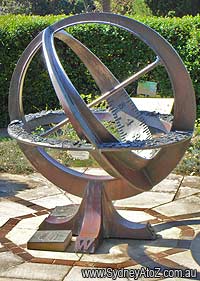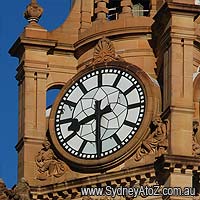| Sunrise: 06:25 | Sunset: 17:22 | GMT +10 | Today: Clear. |
| home | Bookmark this site! | site map | | Your browser did not load the style sheet and as a result the web page is not displaying correctly.
- Cause: You use a low speed connection or the Internet is slow at this time. Solution: Hit the Refresh Button of the browser or click here.
- Cause: Your browser is not complying with the cascading style sheet used. Solution: Update your browser. We recommend Internet Explorer (IE) or FireFox.
You are here: Sydney A to Z (home)
» sydney time
Sydney Time
about time ...

©2006 Gabriel Ditu
Daylight saving time (DST) is the convention of advancing clocks so that afternoons have more daylight and mornings have less.
In Australia different states have different rules:
- Queensland and Northern Territory does not have DST
- New South Wales, Victoria, Australian Capital Territory (Canberra) and Tasmania observe DST
- Western Australia is in a three year trial period.
In Sydney the Daylight Saving Time starts on the first Sunday in October at 2 AM and ends on the first Sunday in April at 3 AM.
| Australian Time Zones | |||||
| City | State | Standard Time | Daylight Time | ||
| Sydney | NSW | AEST | UTC+10 | AEDT | UTC+11 |
| Melbourne | VIC | AEST | UTC+10 | AEDT | UTC+11 |
| Brisbane | QLD | AEST | UTC+10 | ||
| Hobart | TAS | AEST | UTC+10 | AEDT | UTC+11 |
| Broken Hill | NSW | ACST | UTC+9.5 | ACDT | UTC+10.5 |
| Adelaide | SA | ACST | UTC+9.5 | ACDT | UTC+10.5 |
| Darwin | NT | ACST | UTC+9.5 | ||
| Perth | WA | AWST | UTC+8 | AWDT | UTC+9 |
| Currently, where applicable, Daylight Saving Time is Off | |||||
NOTE: Coordinated Universal Time (UTC) is a high-precision atomic time standard. UTC has uniform seconds defined by International Atomic Time (TAI), with leap seconds announced at irregular intervals to compensate for the Earth's slowing rotation and other discrepancies. This allow UTC to closely track Universal Time (UT), based on the Earth's angular rotation.
The difference between UTC and the old Greenwich Mean Time (GMT) is less than 0.9 second. In most cases we can consider that UTC = GMT
Time zones are expressed as positive or negative offsets from UTC. Local time is UTC plus the time zone offset for that location, plus an offset (typically +1) for daylight saving time, if in effect. UTC replaced GMT on 1 January 1972 as the basis for time reference in different regions.
DST history in NSW...

©2006 Gabriel Ditu
DST was introduced again in NSW on 31 October 1971 after the Standard Time Act 1971 was voted by the NSW Parliament.
After a referendum held on 1 May 1976, where 1,882,770 electors were in favor; 868,900 were against and 35,507 votes were informal, DST was adopted on a permanent basis.
Currently in NSW the Daylight Saving Time starts on the first Sunday in October and ends at 3 am summer time on the first Sunday in April.
more...
For more information and astronomy enquiries contact the Sydney Observatory:Watson Road, Observatory Hill
The Rocks NSW
PH: (02) 9241 3767
Web Site: Sydney Observatory
25 April
1809 - The first post office in Sydney established.
1896 - Australian women vote for the first time; in the South Australia parliamentary election.
1915 - ANZAC forces land at Gallipoli in Turkey during the Great War.
1896 - Australian women vote for the first time; in the South Australia parliamentary election.
1915 - ANZAC forces land at Gallipoli in Turkey during the Great War.
Australian slang
- compo Workers' Compensation pay
- B & S Bachelor and Spinster ball
- greenie environmentalist
- clucky feeling maternal
- bikey motorbike
- dog's eye meat pie
- lubra female (Aboriginal word)
- cabbage patcher Victorian
- buster strong wind
Online Maps
Sydney A to Z banners
